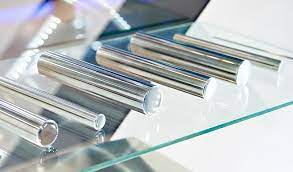Although some nickel is obtained commercially from oxide ores, arsenical ores , and the ores of copper, manganese and iron, at least 85 percent of all nickel production is obtained from sulphide ores.
Pure Nickel is tough, silver-colored metal, rather harder than copper, and of about the same strength, but possessing somewhat less ductility. It closely resembles iron in several of its properties, being malleable and weldable, and perceptibly magnetic, but unlike iron it is little affected by dilute acids, is far less readily oxidisable, and deteriorates much less rapidly under atmospheric influences. For this reason articles of iron and steel are frequently nickel - plated to protect them from rusting. Nickel is much used for cooking utensils, and other vessels for heating and boiling. Nickel enters as a constituent into a large number of ferrous and non ferrous alloys, and frequently finds application as a catalyst in important Industrial processes.
Nickel Alloys which are particularly useful for general industrial purposes are described below :
MONEL METAL :
It is an alloy of 60 per cent nickel , 38 percent copper and a small amount of aluminum or manganese.
It is a white, tough and ductile metal and can be readily machined. It welds without difficultly. It can be heat treated. It is also resistant to corrosion by most agents and has high strength at elevated temperatures.
Monel metal is used in the forms of rod, sheet , wire, and welded tubing. It is widely employed for structural and machine parts which must have a very high resistance to corrosion and high strength as steam turbine blade, impeller of centrifugal pump , etc.
GERMAN SILVER :
An alloy of copper (25 to 50 per cent) , nickel (10 to 35 percent) , and zinc (25 to 35 percent) is known as German Silver. Sometimes, Tin and lead are also added.
It is hard, white and ductile. This is usually of bright silvery color, but may also assume various other pleasing colors by adjusting the proportions of the copper , nickel and zinc. It has in addition to color, good mechanical and corrosion resisting properties. It is also known Ni-Silver.
German Silver is used for making utensils and resistances in electrical work.
INCONEL :
It contains 70 to 80 percent nickel, 10 to 15 percent chromium and the rest iron. It can be used for parts that are exposed to high temperature for extended period. It is less reactive than nichrome to acid.
NICHROME :
This is an alloy of nickel with chromium and is used widely as resistance wire for electrical appliances.
NIMONICS :
A new type of nickel alloy called nimonics are being developed, which by proper heat treatment attain excellent properties for very high temperature service as well as under intermittent heating and cooling conditions. They contain 15 to 18 percent chromium, 15 to 18 per cent cobalt, 3.5 to 5 percent molybdenum, 1.2 to 4.0 per cent titanium, 1.2 to 5.0 percent aluminum , and the remainder nickel.

Comments
Post a Comment